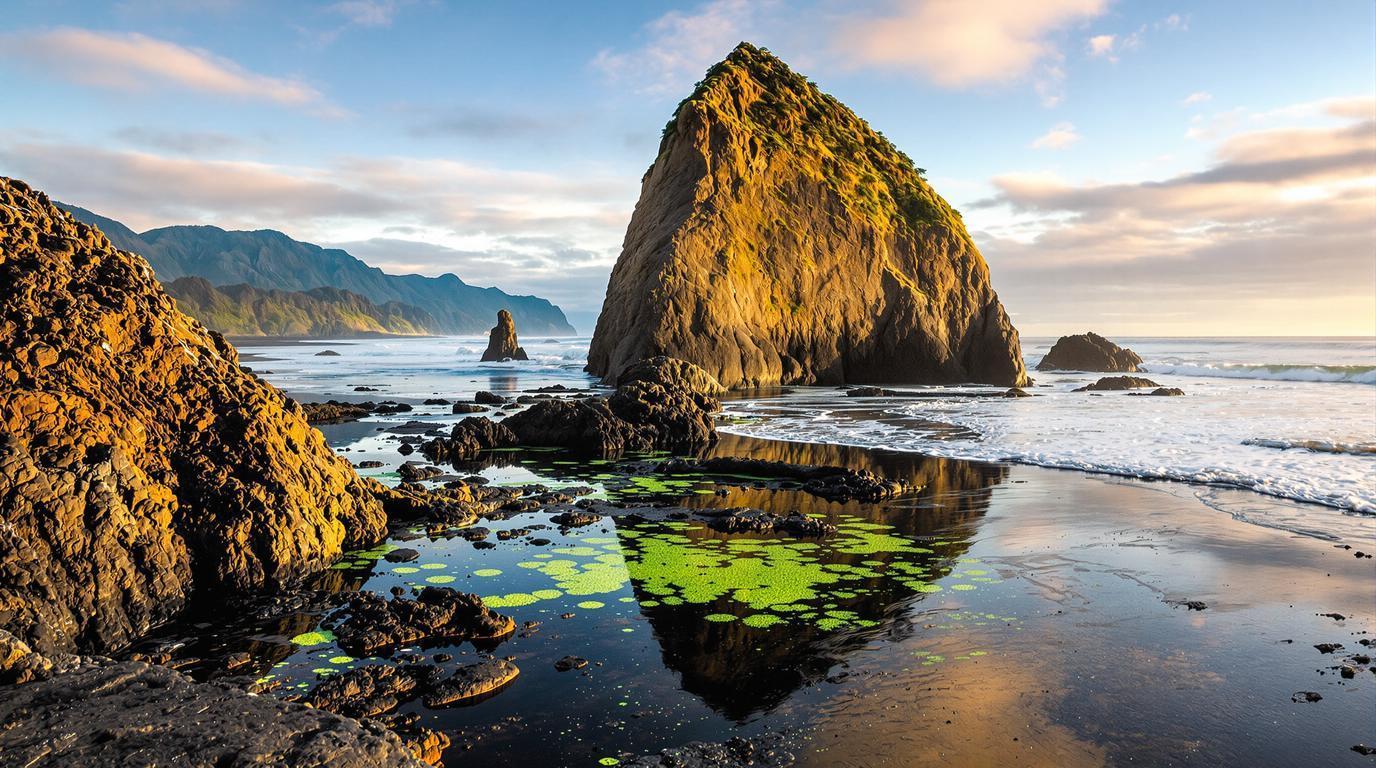Standing before Oregon’s dramatic coastline last summer, I discovered something that completely changed my understanding of Pacific Northwest geology. Cannon Beach’s 235-foot Haystack Rock rises from the ocean like a fortress, its volcanic basalt formations creating silhouettes that mirror Scotland’s Highland coast – yet you’ll experience this maritime majesty for 70% less than a Highland adventure. After exploring both coastlines extensively, I can tell you this Oregon treasure delivers the same rugged beauty, ancient geological drama, and coastal authenticity without the European price tag.
What strikes you first isn’t just the visual similarity to Scotland’s volcanic shores, but the profound geological story these formations tell. While Highland coastal rocks showcase billions of years of Earth’s history, Cannon Beach’s basalt monoliths emerged from Columbia River lava flows 15-17 million years ago, creating equally dramatic scenery with their own unique character.
The town’s 1,900 residents have quietly preserved this coastal authenticity while nearby Seaside draws the crowds just 12 miles north. You’ll find genuine maritime culture here, where Lewis and Clark’s 1806 expedition route still influences the town’s identity, and local artisans maintain traditions that mass tourism hasn’t yet discovered.
The volcanic secret that rivals Highland drama
Ancient lava flows created Oregon’s own Highland landscape
Haystack Rock’s basalt formations originated from the same geological forces that shaped Scotland’s Inner Hebrides, though millions of years apart. These Columbia River Basalt Group flows traveled over 300 miles from eastern Oregon, cooling into the dramatic monoliths you see today. The rock’s 235-foot height creates tidal pools that rival any Scottish sea loch, while its predicted 2,000-3,000 year erosion timeline adds urgency to experiencing this natural wonder. Local marine biologists have documented over 200 species in these protected tidal zones – biodiversity that matches Highland coastal ecosystems at a fraction of the travel cost.
Maritime heritage locals actually share
Unlike Scotland’s often-crowded Highland tours, Cannon Beach’s maritime stories unfold through genuine local connections. The town’s name honors a naval cannon from an 1846 shipwreck, and residents still share tales of vessels that met their fate against these volcanic formations. This coastal maritime heritage rivals Cape Cod’s 300-year legacy, yet remains refreshingly unspoiled by mass tourism.
Travel Note: During my July visit, I witnessed local tide pool guides sharing knowledge passed down through generations – authentic cultural exchange that’s increasingly rare in today’s tourist-saturated destinations.
Hidden coastal authenticity that defies crowded alternatives
The artistic sanctuary tourists overlook
While Highland villages command premium prices for authentic experiences, Cannon Beach’s thriving arts community offers genuine cultural immersion without the European markup. Local galleries showcase Pacific Northwest maritime art, and I discovered glass-blowing studios where artisans create pieces inspired by the volcanic landscape. The annual sandcastle competition draws participants who understand this coast’s unique character – events that celebrate local culture rather than exploit it.
Coastal temperatures that surpass Highland comfort
Oregon’s summer coastal climate delivers what Scotland’s Highlands often promise but rarely provide – consistently pleasant temperatures averaging 65-70°F during July visits. This coastal climate rivals Cape Town’s winter appeal, offering comfortable exploration conditions that Highland weather rarely matches.
The exclusive experience locals protect
Dawn access that reveals nature’s secrets
Haystack Rock’s 350,000 annual visitors miss the coast’s most spectacular moments. Local photographers shared their secret: arriving before sunrise reveals the rock’s silhouette against dramatic Pacific skies, creating Highland-quality vistas without competing for viewpoints. The protected marine sanctuary’s regulations actually enhance authenticity – wildlife flourishes here because access remains respectfully managed.
Regional alternatives that preserve coastal charm
When crowds do arrive, knowledgeable locals recommend nearby Manzanita (8 miles south) or Oregon’s hidden timber sanctuaries that offer similar coastal beauty with even fewer visitors. These alternatives maintain the authentic Pacific Northwest experience while providing escape routes from any seasonal tourist influx.
Frequently Asked Questions
How do accommodation costs compare to Scottish Highlands?
Oregon coastal lodging typically costs 60-70% less than comparable Highland properties, with vacation rentals averaging $150-250 per night versus $400-600 in Scotland’s popular coastal areas.
What’s the best time to experience this Highland-like coastline?
July through September offers the most Highland-like weather conditions, with clear skies and comfortable temperatures that Scotland’s coast rarely provides consistently.
Can you really experience similar geological drama to Scotland?
Absolutely – both coastlines showcase volcanic heritage, dramatic sea stacks, and ancient geological forces, though Oregon’s formations are younger and more accessible year-round.
Cannon Beach proves that authentic coastal drama doesn’t require crossing oceans or paying European prices. This Oregon sanctuary offers Highland-quality scenery, genuine maritime culture, and geological wonders that rival any Scottish coastline – all within driving distance of Portland and at costs that make extended exploration possible rather than prohibitive.
